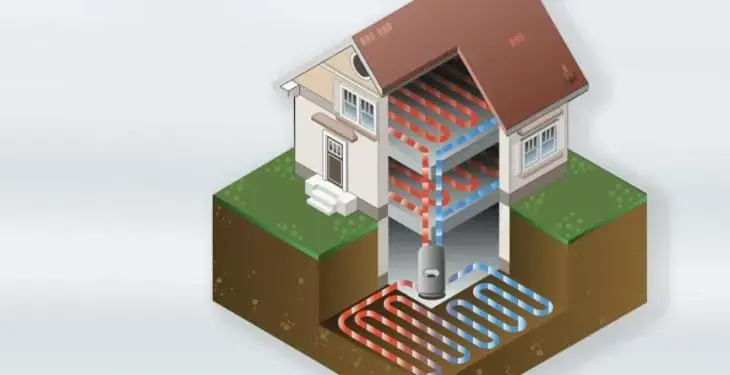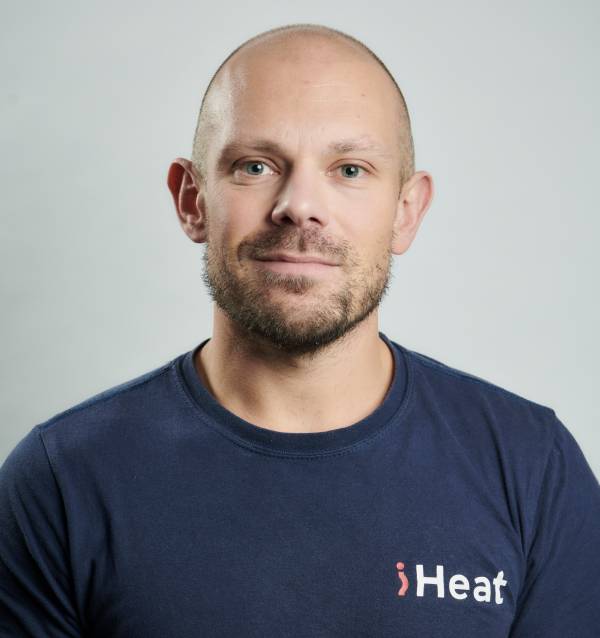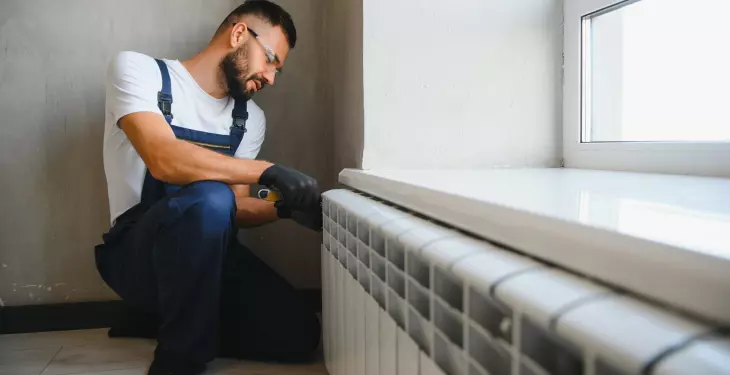

Written by Stephen Day
Gas Safe Engineer
Updated: 30th May, 2025
Ground source heat pumps (GSHPs) can be a great way to meet heating needs for both homes and commercial properties. Before installation, it's important to think about your home’s suitability.
See how much you could save with a heat pump quote.
Ground source heat pumps are becoming a popular choice for those looking to heat and cool their homes efficiently. By using the steady temperature of the earth to provide sustainable energy, they offer a cleaner alternative to traditional heating systems. Ground source heat pumps can significantly reduce energy bills and carbon footprints, making them an attractive option for homeowners in the UK.
Before diving into installation, it's essential to consider whether a ground source heat pump is suitable for your property. Factors include the amount of space available, as these systems often require digging trenches or drilling boreholes. Understanding the difference between horizontal and vertical installations helps determine the best system for a particular location.
Installing a ground source heat pump involves several steps, from assessing the property to laying the required pipework. Costs can vary depending on system size and complexity, with the price for a horizontal system generally starting around £12,000. Choosing the right installer ensures the system operates efficiently and provides the expected benefits.
Ground source heat pumps (GSHPs) can be a great way to meet heating needs for both homes and commercial properties. Before installation, it's important to think about your home’s suitability, the potential need for planning permission, and the space required for a ground loop system.
Before installing a GSHP, it's crucial to assess your property. Good insulation is key to maximising efficiency. Ensure your home has adequate loft and wall insulation. This will reduce energy waste and improve overall heating performance.
Consider the heating needs of your property. GSHPs are more efficient in larger homes or commercial properties due to their ability to offer consistent heating. Fuel costs and potential savings also need to be evaluated to determine cost-effectiveness over time. While installation may be costly upfront, long-term savings can offset this.
Lastly, evaluate the feasibility of installing underground pipes. Homes with particular types of land layouts or restricted access may face difficulties.
Planning permission for GSHPs is generally not required for residential properties. However, checking with local authorities is advised as regulations can vary by area. For commercial properties, permission might be needed, especially if significant land work is involved.
Keep in mind that restrictions could apply in conservation areas or for listed buildings. Always verify local planning guidelines to ensure compliance and avoid delays.
Large-scale installations may also demand additional permissions. Consulting a professional can offer guidance tailored to your property's needs.
The amount of outdoor space available greatly affects the viability of GSHPs. Ground loops require a significant area, often around twice the space of the building footprint. Horizontal loops need more space than vertical loops, which might require boreholes.
Land with easy access and fewer obstructions is ideal. Ensure the outdoor area is clear of large trees and underground utilities.
If space is limited, a vertical loop system may be a better choice despite its higher cost. Evaluating space available will help select the best ground loop design for optimal performance.
A ground source heat pump is an efficient way to heat and cool a home. There are two primary installation types: horizontal ground loops and vertical boreholes. Each has unique features, costs, and requirements.
A horizontal ground loop involves pipes laid out in trenches. These trenches need ample space across a property and are usually about 1.5 metres deep. Horizontal systems are generally less costly due to easier installation on suitable sites.
A vertical borehole digs deep into the ground, requiring less land than horizontal systems. Boreholes are more expensive due to deeper drilling. Vertical systems may be better in urban settings with limited land availability.
Soil type significantly impacts heat pump efficiency. Damp, cohesive soils are ideal as they retain heat well. The high thermal mass and conductivity of moist soils help improve heat transfer from the ground to the system.
Geology and hydrology also play key roles. Areas with good water flow can enhance system performance due to effective thermal exchange. Rocky or dry soils might increase installation complexity and costs.
Yes, ground source heat pumps can be installed with radiators. The system’s ability to produce continuous low-grade heat makes it suitable for homes with existing radiators. However, high-efficiency radiators or low-temperature emitters work best.
It is crucial to check radiator compatibility since some may require upgrades. To maximise system efficiency, ensure radiators are properly sized and installed. With the right setup, using radiators can achieve effective heating while utilising a sustainable energy source.
Installing a ground source heat pump involves several critical steps, starting with planning and ending with ongoing maintenance. Each step ensures that the system operates efficiently, providing reliable heating and hot water.
The installation process begins with a thorough assessment of the site. Experts evaluate the land to determine the best location for the ground loop, considering factors like soil type and available space. They also assess existing heating needs and the potential for energy savings.
Planners take into account the home's current energy distribution system. Underfloor heating compatibility is checked, as it often pairs well with these systems. Specific attention is given to the control systems that will manage both heating and domestic hot water.
Before any physical work starts, it's important to secure the necessary permits and ensure compliance with local regulations. In the UK, this often involves consulting with local councils.
Accredited installers will handle the paperwork, ensuring adherence to building codes. Checking these regulations ensures that the installation is legal and up to standard, which avoids potential fines and system inefficiencies later on. This step lays the groundwork for a smooth installation process.
With assessments and permits sorted, the system design comes next. Engineers create detailed plans specifying the heat pump size and the layout of the ground loop. The design is based on the energy needs of the household.
Different designs cater to various needs, such as integrating geothermal probes for deeper installations or using horizontal trenches for shallow systems. These choices affect how the heat exchanger will connect to the home's heat distribution.
The ground loop installation is a significant part of the process. Pipes are buried about 1-2 meters deep, often in trenches about a metre apart. This depth is vital for capturing stable geothermal energy.
Digging trenches is the common method, though boreholes might be used in limited spaces. These loops act as the ground collector unit, circulating fluid that absorbs natural heat. Proper installation ensures the loop’s efficiency for heat exchange.
Once the ground loop is laid, the next step is installing the heat pump unit itself. This unit is usually placed inside the home, in areas like basements or utility rooms.
The heat pump connects to the ground loop, pulling the absorbed heat from the underground and converting it for domestic use. Connections to the energy distribution system are also established during this step, preparing it for integration with existing home systems.
The connections to the house's heating system are completed next. The pump links to radiators or underfloor heating systems, distributing heat evenly throughout the home. It also integrates with the domestic hot water supply.
Technicians ensure seamless connections, allowing the system to work efficiently with the existing heating infrastructure. Compatibility checks with current systems are crucial to maximise performance and energy savings.
Testing the system is crucial before it becomes fully operational. Professionals perform initial running tests to verify that all components function correctly. They also adjust control systems for temperature and efficiency.
Commissioning involves making necessary calibrations for optimal performance. The goal is to ensure that once activated, the system delivers consistent, reliable heating and hot water. This step marks the transition from installation to operation.
Ongoing maintenance is vital for the longevity and efficiency of the heat pump system. Regular checks of the ground loop and heat exchanger prevent future issues.
Technicians typically examine system controls and monitor energy consumption. Ensuring the pump operates effectively not only maximises energy savings but also extends its lifespan. Ongoing monitoring plays a key role in maintaining system health.
Installing a ground source heat pump (GSHP) involves different costs depending on factors such as the size of the system and the installation method. Grants like the Boiler Upgrade Scheme can help offset these expenses. It's important to compare ongoing running costs of GSHPs with traditional options like gas, oil, and electric boilers to assess long-term savings on energy bills.
The cost to install a GSHP in the UK varies widely based on the specifics of the installation. For a typical residential property, it ranges from £18,000 to £35,000. A smaller 6-8 kW horizontal system could cost around £12,000 to £15,500 to install. For larger systems, such as a 12kW installation, the costs can increase significantly.
Prices can fluctuate based on the technology and supplier. Using available funding can ease the financial burden. Moreover, homes that require more extensive groundwork or larger systems may see costs rise. Hence, getting multiple quotes and professional assessments is recommended.
Several factors impact the cost of installing a GSHP. One major consideration is whether the ground loop is installed in trenches or boreholes. Borehole drilling is pricier than trenching.
The size of the property and heat requirements also play a crucial role. Larger properties or those with high energy demands require more extensive systems, increasing costs. Location can also affect costs due to variations in labour and material prices.
Finally, any additional groundwork or landscaping adds to the price, which can be influenced by the site's geological conditions. Being aware of these factors helps in budgeting the installation effectively.
The Boiler Upgrade Scheme in the UK offers financial aid to support the installation of heat pumps. It aims to reduce the upfront costs and encourage the switch to renewable technologies. Eligible homeowners might receive grants, thus lowering the initial expenses significantly.
This scheme helps in improving energy efficiency and reducing dependence on fossil fuels. It's essential for interested homeowners to check the eligibility criteria and apply for this grant to make the transition more affordable. Proper documentation and a qualified installer are typically required for successful applications.
While the installation cost of a GSHP is higher than traditional heating systems, the running costs are often lower. GSHPs are highly efficient, using renewable energy to provide heating and possibly cooling. This efficiency translates to reduced energy bills over time.
In contrast, gas, oil, and electric boilers might have lower upfront costs but can result in higher fuel bills. Over the lifespan of the heating system, the cumulative savings from reduced running costs can offset the initial investment in a GSHP.
Choosing a GSHP also aligns with the broader goal of reducing carbon emissions and promoting sustainable energy solutions. Comparing the long-term expenses offers a clearer picture of financial benefits, alongside environmental gains.
A ground source heat pump offers a way to capture heat from the Earth, presenting an eco-friendly alternative to conventional heating systems. It promotes energy efficiency, reduces reliance on fossil fuels, and can enhance property value. Evaluating its worth depends on several factors, including cost, environmental impact, and potential savings.
Homeowners with large gardens or land space can reap the most benefits from a ground source heat pump (GSHP). New-build properties are ideal candidates since they can be easily integrated into the design. It especially suits those committed to reducing their carbon footprint and looking for long-term savings on energy bills.
GSHPs are beneficial for areas with stable temperatures underground. This consistency allows them to perform efficiently year-round, providing steady heating and cooling. Individuals aiming to increase property value might also find GSHPs advantageous, as they are seen as a sustainable home feature.
However, not every household will find GSHPs suitable. Properties without adequate land might struggle with the installation. Thus, assessing land size and initial costs are crucial steps in deciding if GSHPs are a worthwhile investment.
Ground source heat pumps leverage renewable energy sources by extracting heat from the ground. They dramatically lower carbon emissions compared to traditional heating systems, making them an environmentally friendly choice. With a lower dependence on fossil fuels, they help in curbing pollution and contributing to cleaner air.
The coefficient of performance (COP) for GSHPs is high, indicating they are efficient in converting energy into heat. For every unit of electricity used, several units of heat are provided, resulting in efficiency and reduced environmental impact.
By using the earth's natural thermal energy, GSHPs help in preserving non-renewable resources. This sustainable method of heating aligns well with global initiatives to combat climate change.
Maximising the efficiency of a ground source heat pump begins with proper insulation. Ensuring that a home is well-insulated will reduce heat loss and enhance the system's performance. A properly insulated home requires less energy, allowing the GSHP to operate more effectively and efficiently.
Utilising solar recharge can also boost efficiency. By combining solar panels with a GSHP, homeowners can reduce electricity consumption, as solar energy assists in providing power for the pump.
Regular maintenance is crucial. This involves routinely checking the system and ensuring that all components are functioning optimally. Clean filters and well-maintained equipment will prolong the life of the GSHP and maintain high-performance levels.
As the world shifts towards renewable energy sources, installing a ground source heat pump can future-proof a home. With energy policies increasingly favouring eco-friendly solutions, GSHPs align with these directives, making them a forward-thinking choice for homeowners.
GSHPs can adapt to technological advancements. As efficiency technologies evolve, current systems often allow for upgrades. This adaptability makes them a sound investment for future energy savings.
Moreover, moving towards renewable heating solutions like GSHPs can significantly reduce dependence on fluctuating fossil fuel markets. This stability in energy supply and costs ensures that homeowners are better equipped for future energy challenges.
Last updated: 30th May, 2025

Written by Stephen Day
Gas Safe Engineer at iHeat
Stephen Day is a Gas Safe registered and FGAS certified engineer with over 20 years of hands-on experience in the heating, cooling, and renewable energy industry, specialising in boiler installations, air conditioning, and heat pump systems.
LinkedInArticles by Stephen Day are reviewed by iHeat’s technical team to ensure accuracy and reliability.

05th December, 2025
Most homes need some radiators upgraded for a heat pump, but usually not all of them.
 Read Article
Read Article

05th December, 2025
Most homes can lower heating costs by combining air source heat pumps with solar panels.
 Read Article
Read Article

28th November, 2025
High temperature heat pumps work like boilers without needing radiators, but they cost mor...
 Read Article
Read Article
No obligation. Takes less than 60 seconds.